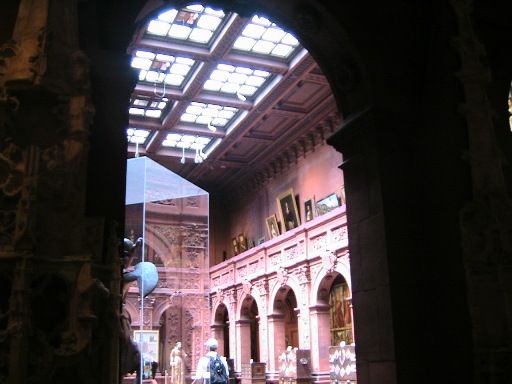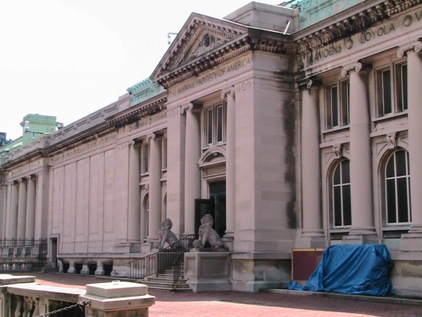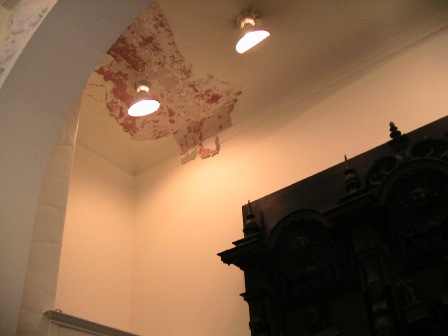|
Spanish Coins Face Stealth Sale by Secret Museum, Frank
Lorenzo Is Said to Change Hispanic Society of America
Byline: Matthew Russell Lee of
Inner City Press, in NYC: News Analysis
NEW YORK, August 6
-- Under a leaking ceiling on 155th Street in
West Harlem, paintings by Goya and Velasquez hang in near obscurity in
the
Hispanic Society of America. Surrounded by the vacant shells left by
museums which
have decamped to lower Manhattan, and with controversial airline
investor Frank
Lorenzo now taking a leading role on the board of trustees, the
Hispanic Society has
taken to selling off the treasures collected by its founder, Archer
Milton
Huntington. Last year a 13th century Koran was sold in London.
On
August
6, Sotheby's began cataloguing for immanent auction a collection of
38,000 coins which Huntington lent to the American Numismatic Society.
The HSA's board of
trustees have assumed unfettered
discretion to under-promote, under-protect and ultimately sell off
Huntington's collection, in a process some analogize to Lorenzo's
treatment of airlines during his heyday.
"This
is to cry," a Spanish art lover sighed during a recent visit.
It didn't have to be this way -- and the coin sale could still be
stopped. Potential bidders should be aware
of the
history, particularly how the sale may run counter to not only the
spirit but
also the letter of Huntington's intent.
Despite
Huntington's transfer of the coins to the American Numismatic Society
being
described as a "permanent" loan, the HSA has fought and litigated to
regain the coins, but only for the purpose of selling them, not for
display. In early 2007, the HSA drafted
a Loan Agreement which gave it the right to cancel Huntington's
transfer. In response to persistent
questions from the New
York correspondent of the Madrid newspaper La Razon, HSA management
denied the
intent to sell the coins. But in a contemporaneous series of court
filings and
letters to the New York State Attorney General viewed by Inner City
Press, the
HSA refers to its board of trustee's January 23, 2008 resolution to
"deaccession" the collection -- museum terminology for selling
off. Then
Sotheby's today began cataloguing the coins for sale.

Inside the Hispanic Society of America on W. 155
St., (c) M. Lee 2008
During an
August 6 visit to the American Numismatic Society's new location at 75
Varrick
Street, Inner City Press observed a team from Sotheby's and a spin-off
company
specializing in coin sales, Morton & Eden, preparing to catalogue
the coins,
which number 38,000. A sworn affidavit by Sotheby's David Redden spells
out the
auction house's demands during the cataloguing process: a separate,
carpeted
room to which they will have their own key, Internet access and,
strangely, the
right to bring in their own food. Once catalogued, the coins will be
sold the
highest bidders. Pending a legislative proposal in New York
State, A995A, which would limit the uses of
"deaccession" profits, the Lorenzo-led Hispanic Society of America
could put the proceeds to any use whatsoever.
Lorenzo is
best known for the bankruptcy of Eastern Airline; he has been described
as,
among other things, a "vulture investor." Now,
museum sources say, he is applying to same slash
and burn philosophy to the Hispanic Society of America, moving to sell
off
anything that is not nailed down. "It's a social club for a handful of
businessmen," one well-placed source complained, describing these
"gentlemen's" jockeying to meet Spanish royalty and other European
dignitaries and titans of commerce.

Exterior of Hispanic Society of America, (c) M. Lee 2008
Archer
Milton Huntington, himself the adopted son of a railroad magnate,
stumbled into
appreciation of Spanish art after reading a then-popular book about
gypsies,
George Borrow's The Zincali. He
traveled to Spain and bought art works and coins. The museum opened in
1908, on
land he purchased from naturalist James Audubon. Huntington gave 30,000
of the
coins he had collected to the Hispanic Society and then, according to a
HSA-printed biography, "in 1946 placed [the coin collection] on
permanent
loans with the American Numismatic Society."
But
in the
years after Huntington's death in 1955, the Hispanic Society museum
drifted
from its mission. By 1993, the Commissioner of New York City's
Department of
Cultural Affairs, Luis Cancel, accused the HSA's board of trustees of
failing
to engage with the museum's largely-Hispanic neighbors. The Society's
then-director
responded that the area would soon be gentrified, which largely has yet
to
happen.
A visit to
the museum by this reporter on a recent Sunday found only a handful of
tourists
and two security guards. The Society's library was closed to the
public, and 16th
century wood carvings sat under a leaking ceiling with peeling paint.
Upstairs,
rare ceramics sat on the floor next to electric fans of the type sold
in
discount stores, protected only by a two-foot high strip of plastic or
Lexan. Even
though no direct comment was offered for this initial story, it emerged
that
the HSA's trustees have also considered leaving 155th Street, but
concluded
that space lower in Manhattan was too expensive. Whether the subprime
crisis
changes that, or explains the shameless sell-off, is not yet clear.
It is noteworthy,
as least in coin and ceramic circles, that the Euphronios-painted "hot
pot" that the Metropolitan Museum of Art had to return to Italy was
purchased in 1972, with proceeds from the Met's controversial sale of
its coins,
which had been on loan to the American Numismatic Society. Call it
karma or a
cautionary tale.

Leaking ceiling over 1600 wood carving at
HSA, (c) M. Lee 2008
A review
of tax returns of the Hispanic Society of America lists the HSA with
$29
million. But if the Society's representations in its legal papers about
the
small percentage of its assets made up by the coins are true, its
assets would
be up to thirty times higher. Marcus Burke and Patrick Lanaghan are
listed as annually
receiving $65,000 and $63,000, respectively, along with $30,000 each in
deferred compensation. Other trustees beyond Frank Lorenzo include
William R.
Harman, Miner H. Warner and George B. Moore, who signed the Trojan
horse
revised loan agreement, and who works at Merrill Lynch.
None of
these were present on Wednesday when Sotheby's began final cataloguing
of the coins
at the American Numismatic Society. The Sotheby's group were behind a
locked and
secured door, presumably with the lunch they had brought in. Archer
Milton
Huntington, one imagined, was rolling in his grave. Will his voice and
intent
be heard, before at Frank Lorenzo's direction, Huntington's hard-won
collection
disappears into the hands of the highest bidder?
Watch this site.
And
this --
|